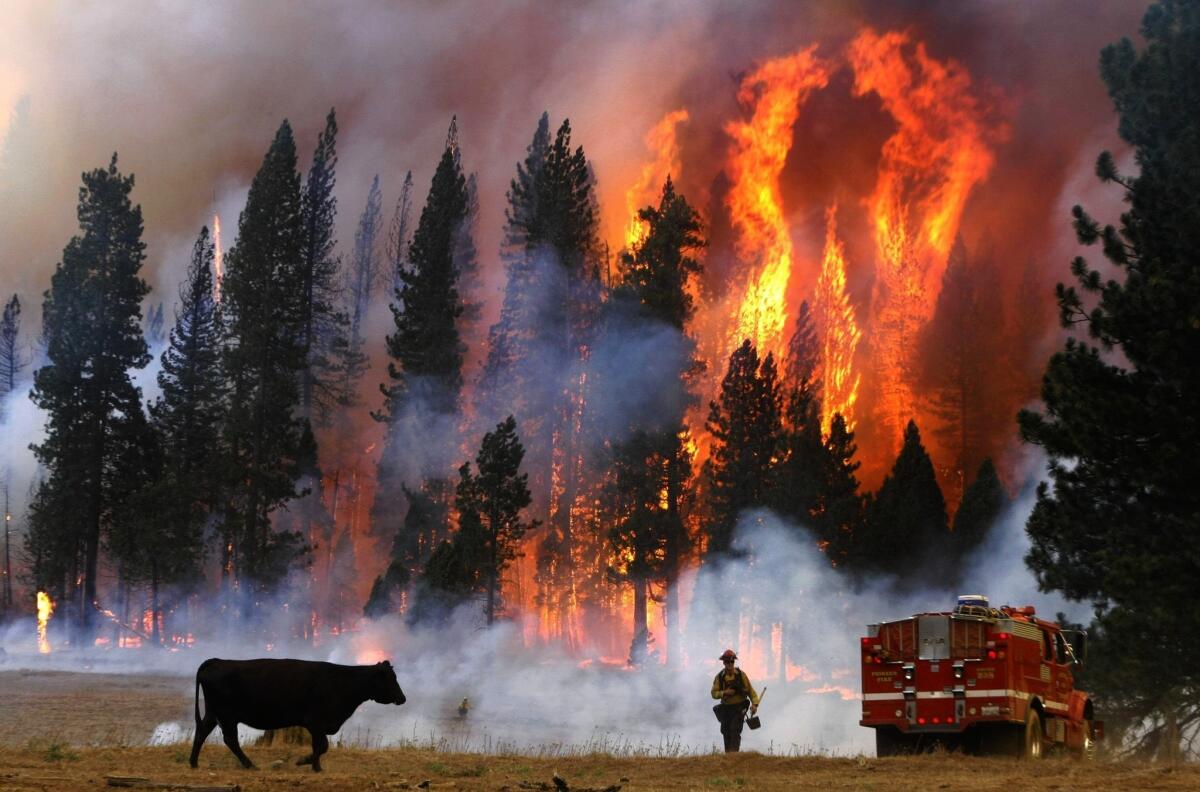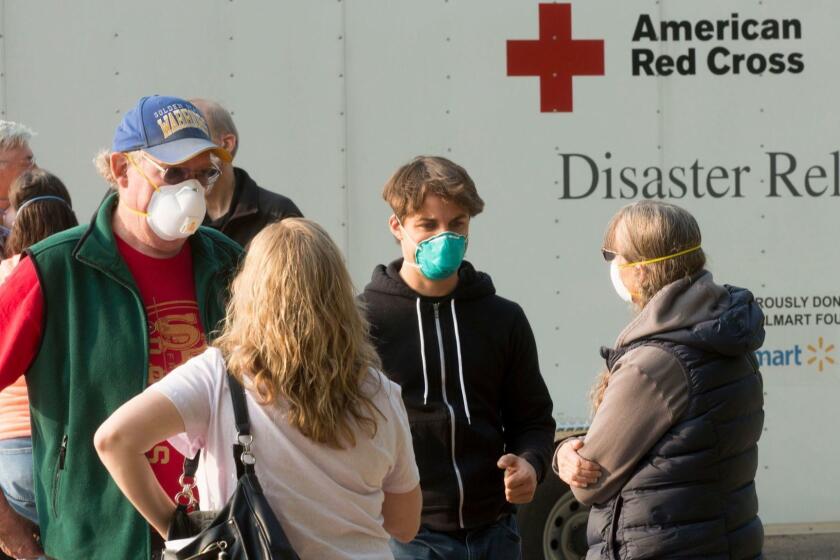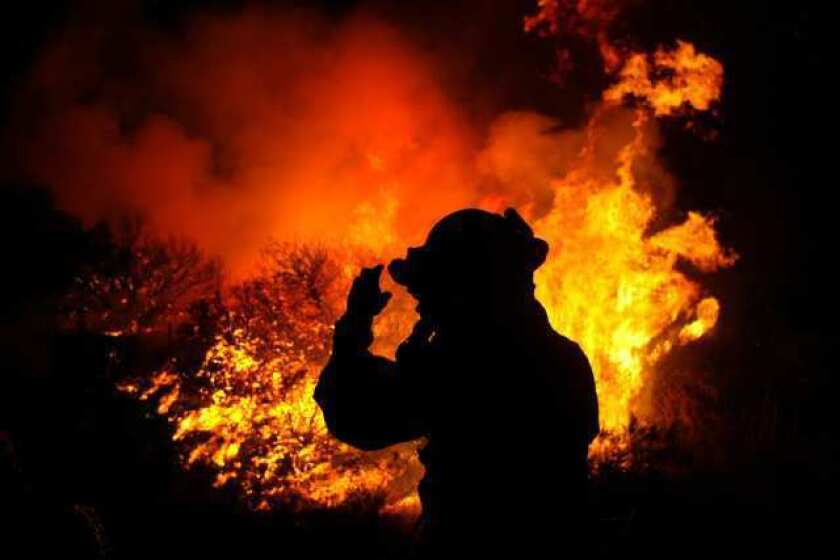California faces a perilous fire season as coronavirus threatens firefighters

- Share via
As forecasters predict higher-than-normal chances of large fires in Northern California this year — as well as the usual risk of “large significant” burning in Southern California — fire authorities are growing increasingly concerned over their ability to muster a large, healthy force of firefighters in the face of COVID-19.
Realizing that wildfire smoke will steadily impair a firefighter’s immune system, and that traditional base camps can magnify the risk of infection, federal, state and county officials are urging a blitzkrieg approach to wildfires that will rely heavily on the use of aircraft.
With the coronavirus still circulating, they say they cannot allow even the smallest secluded fire to smolder for the sake of forest ecology. All fires, they say, must be extinguished as quickly as possible.
By the time fire season arrives, officials hope the spread of COVID-19 will taper off, but preparations are already being made.
“Unfortunately, this is not a year in which we can afford to assign firefighters to monitor and manage such wildland fires,” Sen. Lisa Murkowski (R-Alaska) wrote to the departments of Interior and Agriculture recently as she urged aggressive firefighting in Northern California and other parts of the West. “Given the unprecedented conditions in this fire season, it is essential to utilize federal resources for immediate wildfire suppression to the greatest extent practicable.”
The call for highly aggressive firefighting marks a return to an older ethos, particularly on federal lands, where most California forests are.
For most of the last century, the federal government’s policy was to knock down every fire wherever it sprang up. In recent decades however, a different approach has evolved: Fires that don’t pose a threat to the public are allowed to expand naturally, and burn away overgrowth. That is unlikely to be the case this fire season however, as protections against the spread of the coronavirus place new strains on fire agencies and their crews.
In many ways, the coronavirus is sending wildland firefighters back to the old school this fire season.
“Aggressive initial attack is the single most important method to ensure the safety of firefighters and the public; it also limits suppression costs,” said Jessica Gardetto, a spokesperson for the Bureau of Land Management at the National Interagency Fire Center.
Even with the increased use of aircraft however, fire authorities still face a hard reality. Planes and helicopters are effective in slowing most fires, and allow crews on the ground to get on the scene and contain it, but history shows they do little to halt the wind-driven monsters that cause the most death and destruction.
The continued spread of the coronavirus, as well as the economic paralysis that has accompanied health restrictions, has impacted every aspect of wildland firefighting, including mutual aid arrangements and the widespread use of inmate firefighters.
“Speaking across the board, this is a game changer with COVID-19,” said Mike Mohler, spokesman for the California Department of Forestry and Fire Protection. “It’s going to have to be an ‘everybody’s hands on deck’ approach to this.”
Mohler said his biggest concern is firefighters contracting COVID-19 and silently spreading it among fellow firefighters and knocking them out of service, or even spreading it among the public.
Already, the coronavirus has reduced the number of overall firefighters available in California.
When coronavirus infections spiked in state prisons, authorities granted early release to thousands of minimum-security inmates in an effort to reduce crowding and slow the spread of disease. Of those releases, 242 were inmate firefighters, according to the California Department of Corrections and Rehabilitation. Inmate firefighters make up 43% of the state firefighting force.
In Los Angeles County, where voters recently rejected a measure to hire more firefighters and paramedics, Fire Chief Daryl Osby said potential staffing shortages and increased brush growth due to late-spring rains are cause for worry.
Aiming to take a more aggressive posture toward wildfires, crews are preparing five of the county’s water-dropping helicopters to deploy during the day and night throughout the summer. The county is also planning to contract with two air tankers from Canada in August — a month earlier than usual, Osby said.
And, later this month, crews will begin inspecting wildfire-vulnerable homes to ensure that they have fire defensible space.
“It’s going to be really important for our citizens to do the proper brush clearance,” Osby said, “because when we get toward the fall months and start having our wind-driven incidents, we cannot guarantee to place an engine at every home.”
Traditionally, California has been able to rely on its mutual-aid system for backup. The system, which sends local fire departments to battle wildfires in other jurisdictions, is experiencing heavy strain that could intensify as COVID-19-related budget shortfalls hit municipalities hard.
Among them is the Seaside Fire Department in Monterey County, where the firefighters’ union recently agreed to a 10% pay cut amid a citywide hiring freeze. Layoffs and early retirements that were being considered have been avoided for now, said Jason Black, the president of the firefighters union.
But for how long is unclear.
“I don’t have a crystal ball,” Black said, “it’s like everybody else, it depends on the rebound of the economy as the shelter in place gets lifted.”
As catastrophic windblown blazes strike with more frequency, California’s system of mutual-aid firefighting is cracking, with fire chiefs sometimes reluctant or unable to assist their counterparts.
In an effort to limit the transmission of illness among wildland firefighters, officials are adjusting the layout at fire base camps, where fire crews traditionally eat, sleep and bathe in close quarters, along with many caterers and contractors. Even before the COVID-19 pandemic, outbreaks of “camp crud” were notorious in such environments, and a union representative for the U.S. Forest Service has likened them to “cruise ships on land.”
Cal Fire said its camps may end up taking up a larger footprint, such as two fairgrounds instead of one, or a large parking lot, to provide adequate spacing among crews.
Either way, firefighters battling flames on the front lines and communities downwind will be more vulnerable to infection because of their smoke exposure, said Dr. John Balmes, a volunteer physician with the American Lung Assn. and a member of the California Air Resources Board.
“Wildfire smoke is kind of like cigarette smoke — a mixture of carbon-based particles and irritant gases,” Balmes said. With the body’s immune system preoccupied battling these foreign invaders in the lungs, that gives it less ammunition to fight the coronavirus, Balmes explained.
In California, a soggy spring has so far kept the 2020 fire season at bay. In states where fires have already begun however, fire crews are learning that protections against the coronavirus — cleaning, distancing and wearing masks — can become burdens when trying to respond to wildfires.
Shawn Faiella, superintendent of the Lolo National Forest’s interagency hotshot crew in Montana, summed it up this way in a report to the federally funded Wildland Fire Lessons Learned Center: “It is damn tough to take these practices to the fireline.”
On the long drive to an incident, firefighters avoided drinking water, out of concern about touching their face masks, and increased their risk of dehydration. They also traveled in more vehicles than usual, to ensure proper distancing, and thereby increased their chances of a crash — one of the leading causes of death for firefighters.
“If this had been an emerging incident with evacuations, tight road parking, smoke, and significant fire growth, not only would this be an impossible feat to park all the vehicles — we would be putting my crew in significant danger. And we just arrived on incident,” Faiella wrote.
Finding places to eat in states with shelter-at-home orders proved difficult as well, as did maintaining social distance with colleagues on the fire line and the public who approached with questions. Routine things to speed up a firefight like sharing equipment between agencies now violate COVID-19 guidelines.
“If the intent is to fight fire, there needs to be an understanding that COVID-19 social distancing recommendations cannot be fully adhered to when engaged in firefighting,” read a report from the April 17 Verde fire in Colorado. “The question needs to be answered: does a lack of completely adhering to COVID measures mean less engagement or not?”
Frank Carroll, a retired 31-year veteran of the U.S. Forest Service, has a son who is a federal hotshot firefighter. He and his fellow crew members were looking to older practices in firefighting in order to deal with coronavirus concerns.
For example, his son’s crew started loading extra vehicles with 14 days’ worth of rations for each firefighter, in case they get infected and have to quarantine, then march into the forest and eat and sleep where they work, instead of returning to a large base camp with hundreds of others.
“It’s really old school but you know what? Old school worked really well,” Carroll said.
More to Read
Sign up for Essential California
The most important California stories and recommendations in your inbox every morning.
You may occasionally receive promotional content from the Los Angeles Times.













